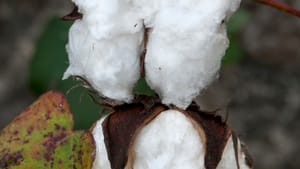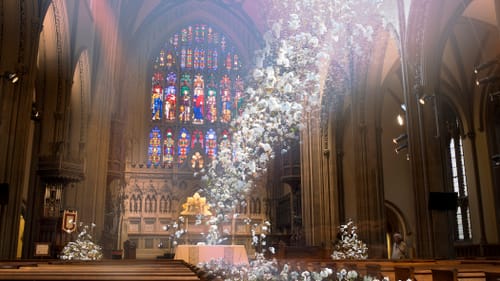Stay in the Loop
BSR publishes on a weekly schedule, with an email newsletter every Wednesday and Thursday morning. There’s no paywall, and subscribing is always free.
The fabric of enslaved lives
AAMP presents John Dowell's 'Cotton: The Soft Dangerous Beauty of the Past'

John Dowell celebrates cotton’s delicacy and commemorates its hellish history in the African American Museum in Philadelphia's (AAMP's) Cotton: The Soft, Dangerous Beauty of the Past. The concept came to the photographer and printmaker in dreams of his grandmother, who was raised in South Carolina.
“I began to photograph cotton, and its floating, near-spiritual beauty came to represent lost souls and our relationship to our past,” he says. “I realized Big Mommy, my grandmother, had led me to my ancestral connection to slavery.”
Slave market to stock market
Several of the large photographs were shot in New York City, serving notice that slavery did not end at the Mason-Dixon Line. New York hosted the second-largest slave market in the United States in the heart of the Financial District.
Enslaved laborers of African-American and Native American ancestry were sold on Wall Street from 1711 to1762, and by the middle of the 18th century, enslaved people accounted for about 20 percent of the city's population. New York state did not completely abolish slavery until 1841.
Mannahatta Park, a pocket park on the site of the Municipal Slave Market, is the subject of Dowell’s Do They Remember? (2017). It’s early evening and homeward-bound workers are immersed in commuting rituals: awaiting buses, checking phones, waiting for traffic lights to change. At the crosswalk, a red hand glows, forcing them to pause.
In Bursting Out (2017), he interspersed giant branches loaded with bolls between pillars framing the ground floor of 75 Wall Street as traders leave for the day.
“I’m interested in this idea of what’s real or not real,” Dowell has said of his preference for shooting at dusk. “At this time of day, the reflections are picking up… I’m trying to take you in the space, to penetrate beyond the surface, the façade of the building.” In Cotton, he takes viewers beyond the façade of the present moment.
Erasing a village
In 1857, New York demolished a thriving neighborhood to clear land for Central Park. Seneca Village was the city’s first middle-class African-American neighborhood. Dowell explores it like an archaeologist in reverse, layering past over present, superimposing displaced structures and residents atop running paths, shaded benches, and curated views.
Present-day condos overlook a clearing in The First Settler, Andrew Williams (2018), in which Dowell inserts a ghostly cabin and a flock of male cardinals. The bright red birds are thought to be spiritual messengers.
He resurrects the settlement’s religious life in All Angels’ Church of Seneca (2018) and African Union Church (2018), adding cotton fields across lawns, having a volcano of bolls erupt from a steeple, and launching single blossoms into the air, a squadron of tiny angels.
There’s a surviving graveyard in The Spirits of AME Zion Church (2018) and a man walking his Westie terrier. Dowell has drawn the church, planted photographs of cotton between the tombstones, and inserted three sepia parishioners — a small girl at the church door, a woman with a long skirt and sunhat hanging down her back, and a well-dressed gentleman with hand on hip, as if to say, “What are you looking at?”

Sending the Message (2017) is Dowell’s most beautiful and poignant image. He has filled a very real and majestic sanctuary with images of cotton. Plants populate pews and process up the center aisle as downy orbs float to freedom, rising like prayers along a shaft of sunlight.
Enslaved-eye views
A second group of photographs focuses on the cotton plant itself, and a vein of red runs through them. Only those who’ve spent time around cotton crops know that the blossoms begin as creamy white flowers that, on the second day, turn rosy pink and then deep red.
Dowell provides these fleeting images, accompanied by panoramic photographs of Southern cotton fields ready for picking, puffy white tufts encased in tough capsules. Trying to pluck the soft bolls quickly from their pointy, sharp-edged shells inevitably bloodies fingers, hands, and arms.
The field images are hung at eye level, evoking a sense of standing in high cotton. Dowell’s grandmother knew. She’d told him of becoming lost in a cotton field as a child. By the time she’d struggled out, she was covered in deep cuts. Which Way? (2012) makes it easy to identify with a small girl — or, for that matter, an enslaved picker, wanting nothing more than to escape but not knowing the way home.
Common history
A Moment of Reflection (2017) caps the exhibit. The installation enables visitors to consider what cotton means in American history, and how deeply slavery affected American families. Designed like a small altar, its back piece is formed with cotton branches. There are a few chairs, and two baskets hold cotton bolls for people to handle.
A sign invites visitors to leave family photos, and some have. “Feel the emotional presence of our shared history,” the sign suggests, “while grasping the present and advancing to the future.”
What, When, Where
Cotton: The Soft, Dangerous Beauty of the Past: Photographs by John Dowell. Through January 21, 2019, at the African American Museum in Philadelphia, 701 Arch Street, Philadelphia. (215) 574-0380 or aampmuseum.org.
Sign up for our newsletter
All of the week's new articles, all in one place. Sign up for the free weekly BSR newsletters, and don't miss a conversation.
